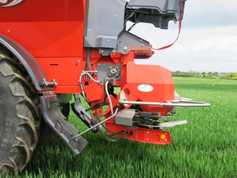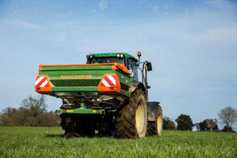Nitrogen (N) is one of the most important nutrients for grass growth and its application has a direct effect on DM yield. The response in growth to N can be as high as 1kg N per 15kg DM grass. A bag of 27.5 CAN contains 13.5kg of N, so this can correspond into 200kg DM grass growth.
Nitrogen (N) is one of the most important nutrients for grass growth and its application has a direct effect on DM yield. The response in growth to N can be as high as 1kg N per 15kg DM grass.
A bag of 27.5 CAN contains 13.5kg of N, so this can correspond into 200kg DM grass growth.
Recent Teagasc research at Grange, Co Meath, demonstrated that the most efficient time to spread chemical N was in spring when soil temperatures reach a consistent 5°C to 6°C.
Looking back across 20 years of weather data in Grange, it has been 6 March before soil temperature has reached a consistent 6°C.
Looking at soil temperatures this week around the country, they range from 8°C to 10°C, so fertiliser should be one of the first jobs on the list as soon as ground conditions allow.
What fields to target
Target early nitrogen applications to your most productive swards, as they will give you the best response. These should be:
Recently reseeded swards.Ryegrass dominated swards.Fields with medium covers (5cm to 7cm).Fields that are high for all other nutrients, ie P, K, pH.Other fertiliser tips
Wait for soil temperatures to reach a consistent 5°C to 6°C before spreading.Beef farms stocked at 140kg/organic N should be spreading one bag 27.5 CAN or a half-bag of urea in March on grazing fields and another 20 units/acre of N in April.Cost per kg N (March 2017): CAN €230/t for 270kg N = €0.83/kg N; UREA €330/t for 460kg N = €0.71/kg N.Urea works out cheaper than CAN. However, it needs cold damp conditions for application and is more prone to N loss.Use soil tests to determine what P and K status is like across the farm. Fields deficient in P, K and lime would be better served with a compound application like 18:6:12, or better still target these fields for slurry application.Avoid spreading high K compounds in spring where lactating animals are grazing. K can displace magnesium and lead to the onset of grass tetany.Leave 10 days between slurry and fertiliser applications, as slurry creates anaerobic conditions and could lead to the loss of N.If liming land, leave three to six months between application and spreading of urea or slurry to avoid N losses.Heavy covers (1,200kg+, 9cm+)
These are usually the first fields closed in autumn around early October and, therefore, should be the first fields grazed in spring.
These fields will have accumulated grass over the winter months, especially during mild winters like we have just had. If these fields were not grazed out fully in autumn, there may be an accumulation of dead matter at the base of the sward.
This grass is still very digestible, with feed values of up to 70DMD, which is better than most grass silages this year. However, it is important to graze this sward tight on the first grazing in spring.
If this dead matter is allowed to accumulate after first or second grazing, it will reduce the quality of grass grown in subsequent rotations and, more importantly, the growth potential of the field, as this dead matter will not capture sunlight to take in nutrients to grow.
Dos
Go to heavy covers first.Graze out tight.Don’ts
Delay turnout of stock on to these covers.Spread fertiliser or slurry on these covers.Move stock on early without grazing out these covers.Medium covers (500kg to 1,200kg, 6cm to 9cm)
These fields would have been closed up in late October or the first week of November. These are the fields that will respond best to fertiliser in spring.
If slurry could be spread via a trailing shoe, these covers could get slurry instead of chemical N, as the trailing shoe enables stock to graze quicker after slurry compared with a conventional splash plate.
These fields will then be ideal to graze in two to three weeks. Grazing these swards too quickly will mean you may run out of grass too early and finish the first rotation too quickly.
On the other hand, if you are behind target and have been delayed in turning out stock, grazing some of these light covers will speed up the rotation and help you hit your targets.
Dos
Target medium covers with fertiliser or trailing shoe-applied slurry.Don’ts
Apply slurry with splash plate to these medium covers.Light covers (<500kg, 4cm to 6cm)
These fields will have been closed from mid-November onwards and will have in the region of 4cm to 5cm on them at this stage (<500kg DM).
These fields are ideal for slurry applications, as no grass will be damaged in the slurry spreading process.
Spread in dull, damp cold conditions to achieve maximum N recovery from spreading.
As it will be at least three weeks before these paddocks are ready to graze, that makes them ideal for slurry.
![]()
Dos
Apply slurry to light covers as soon as ground conditions allow.Aim for dull, damp, cold conditions when spreading slurry.Don’ts
Spread fertiliser on light covers.Graze light covers first. 




SHARING OPTIONS: